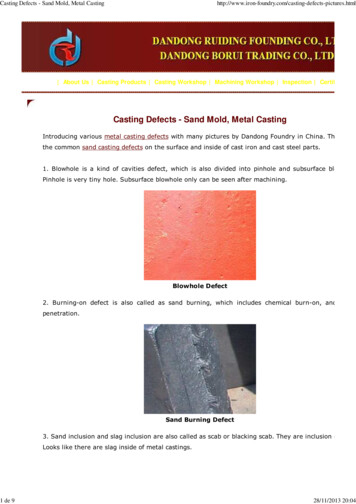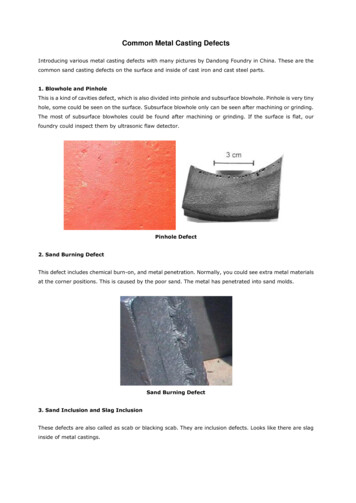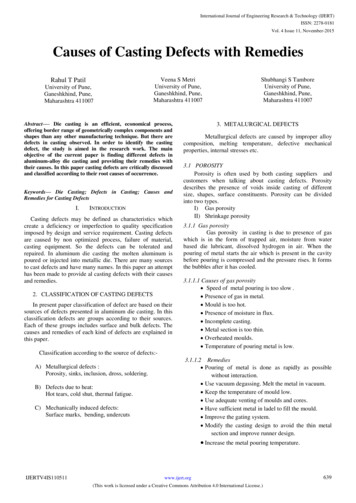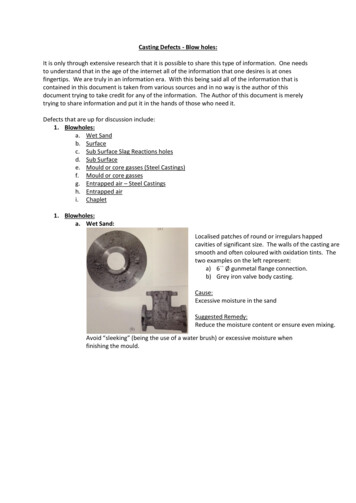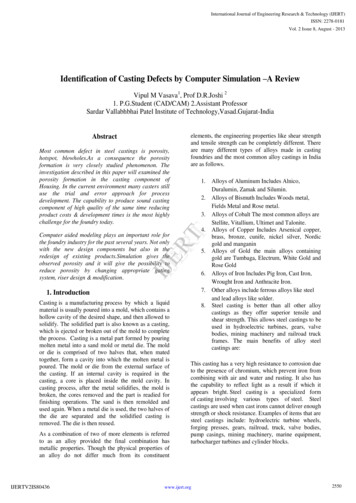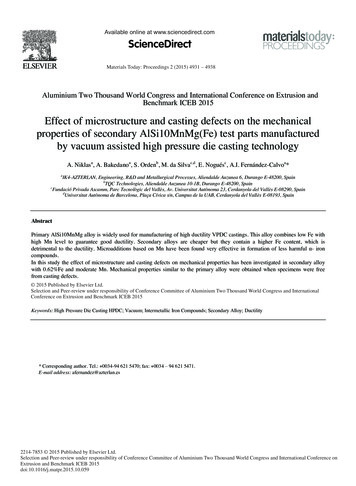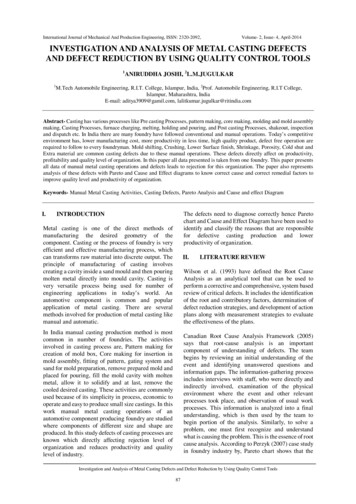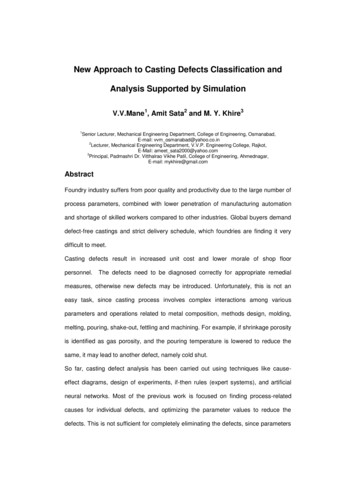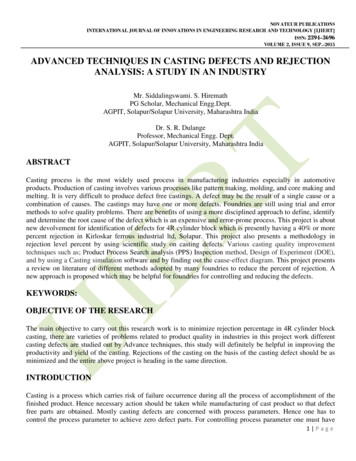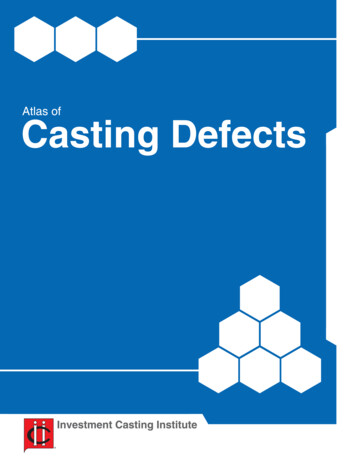
Transcription
Atlas ofCastingDefectsInvestment Casting Institute136 Summit AvenueMontvale, NJ 07645-1720Phone: 201-573-9770 Fax: 201-573-9771www.investmentcasting.org
IntroductionThis manual is provided to assist both process engineers and manufacturing personnel to identify defectsin castings. It offers suggested remedies to reduce or eliminate the defect.The manual provides an easy-to-use format. Photos provide a visual of the defect; text provides a list ofprobable causes and the suggested remedies.AcknowledgmentsThe Investment Casting Institute wishes to thank all of the members of the Institute’s Publication andCasting Committees who provided information, photographs and valuable resources. This excellentsupport has made it possible to create this Atlas of Casting Defects, an educational tool that will be ofgreat value to the industry now and in the future.Casting Committee4Chairman:Nipendra SinghS&A Consulting Group LLPMembers:Steve SikkengaGowri ShankarTibor OravecThomas ThorntonCannon Muskegon CorporationPCC SMP PlantKovatch CastingsS&A Consulting Group LLPPhotography:Tibor OravecKovatch CastingsEditing:Leland MartinInvestment Casting Institute
Table of ContentsAcknowledgments & Introduction. 4Cold Shut. 6Cut-off Damage. 7Gas. 8Gas (Air Entrapment). 9Slag. 10Hot Tears. 11Inclusion. 12Ceramic Inclusion. 13Excessive Metal from Shell Failure. 14Mold Cracking, Finning. 15Non-fill/Misrun. 16Primary Coat Buckle. 17Rat-tailing/Oxidation Crazing. 18Shell Buckle. 19Shrink in Gate Area. 20Shrinkage (Surface). 21Wax Flow Line. 22Investment Casting Institute136 Summit AvenueMontvale, NJ 07645-1720Phone: 201-573-9770 Fax: 201-573-9771www.investmentcasting.orgCopyright reserved: Neither the Investment Casting Institute nor its officers acceptlegal responsibility for information, advice given or opinions expressed.Revised 01-2004
Defect: Cold ShutAppearance of Defect:Linear indication of metal not joined at time oftwo metal streams meeting.Probable CauseSuggested Cure1Low metal pouring temperature.1. Increase metal and/or mold temperature.2Poor pouring practice.2. Increase head pressure and/or rate of pour; avoidsplashing.3. Improper gating.3. Improve gating to enhance mold fill.4. Low shell permeability.4. Increase shell permeability and/or add vents.5. Heavy oxidation of metal increasing surface tension.5. Melt under controlled atmosphere or vacuumconditions.6. Low metal fluidity.6. Modify alloy composition to enhance fluidity.6
Defect: Cut Off DamageAppearance of Defect:Metal removed during gate cut-off withevidence of abrasive wheel and/or sawdamage to casting.Probable CauseSuggested Cure1. Improper design of casting tree.1. Ensure sufficient clearance for necessary bladethickness while removing castings from tree,lengthen the gate.2. Worn and/or dull saw blades.2. Maintain cutting edges on blades and abrasivewheels to prevent walking.3. Improper fixturing by operating personnel.3. Improve fixturing to minimize mistake and improvesafety.7
Defect: GasAppearance of Defect:Generally spherical or teardrop shapedcavities which may or may not containevidence of oxidation.Probable CauseSuggested Cure1. Improper or insufficient deoxidation.1. Revise or increase deoxidation technique.2. Metal held at superheat temperatures for extensivelength of time.2. Control time at temperature and cast at lowesttemperature possible.3. Dirty, wet or contaminated (rusty) charge materialsalong with possible moist ladles and furnace linings.3. Clean all materials charged. Be sure moisture isremoved from refractory materials.4. Low shell permeability.4. Improve permeability by using fewer coats andincreasing size of refractory particles.5. Improper burnout.5. Increase burnout time, increase oxidizingatmosphere in burnout furnace, increase burnouttemperature.8
Defect: Gas (Air Entrapment)Appearance of Defect:Rounded smooth walled cavities which mayexhibit a slightly oxidized surface.Probable CauseSuggested Cure1. Turbulent metal flow.1. Reduce pouring height between vessel and mold.Modify gating to reduce turbulence, possiblyestablish a self venting feeding system and alsobottom feeding.2. Low shell permeability.2. Use coarser refractory particles, use fewer coats,vacuum assist during pour, increase sprue height.9
Defect: SlagAppearance of Defect:A series of cavities of irregular and symmetricalshape indicative of slag and/or refractoryparticles producing the irregular shapes andgas producing the symmetrical shapes.Probable CauseSuggested Cure1. Improper deoxidation.1. Revise deoxidation technique.2. Metal held at superheat temperatures for extensivelengths of time.2. Reduce time at temperature and cast at lowesttemperature possible.3. Dirty, wet or contaminated (rusty) charge materialsalong with possible moist ladles and furnace linings.3. Clean all materials charges. Be sure moisture isremoved from refractory materials.4. Impurities within metal being melted (i.e. slag,refractories, rust on surface, etc.).4. Use clean melt stock.5. Particles of refractory from furnace ladle, furnace lipand ladle lip.5. Ensure lips of furnace and ladle are free ofrefractory particles prior to use.6. Improper slagging practice.6. Ensure adequate supply of slag bars and trainingto melter. Use cobalt blue glasses while slagging.Additions of ceramic/cloth filter reduces inclusions.7. Incorrect deoxidation practices.7. Reduce/optimize superheated and melt temperature.10
Defect: Hot TearsAppearance of Defect:Intergranular crack exhibiting oxidizedfracture interface.Probable CauseSuggested Cure1. Restrained by gating.1. Modify the gating.2. Shell too strong.2. Reduce shell strength.3. Sharp inside corners.3. Increase generously all radii.4. Bad casting design.4. Eliminate thick, thin sections.5. Movement of shell before alloy solidified.5. Allow sufficient time for solidification before movingthe mold.6. Improper metal or shell temperature.6. Establish and control to proper temperature.7. Faster cooling rate after pouring (duringsolidification).7. Reduce the cooling rate by insulating the mold.8. Improper chemistry of alloy.8. Modify chemistry of alloy.11
Defect: InclusionAppearance of Defect:Irregular cavities possibly containing tracesof refractory and/or slag particles.Probable CauseSuggested Cure1. Sand/refractory particles in shell.1. Clean shell prior to pour (vacuum or turn upsidedown and empty).2. Dirty melt stock.2. Remove rust, foreign surface contaminants, checkfor surface slag and/or sand clusters.3. Foreign material from crucible/ladles.3. Use proper refractory and keep free fromcontaminants (i.e. good slag practice, etc.).4. Poor wax assembly of gate to sprue in wax room.4. Seal all undercuts to prevent flashing and chipping ofshell interior.5. Refractory contained in melting stock.5. Use clean melting stock.6. Slag entrapped during pouring.6. Use adequate deoxidation and slagging practices.Modify runner system to reduce turbulence. Useteapot spout ladle.Note: Use of ceramic cloth filter reduces inclusionrelated defects.12
Defect: Ceramic InclusionAppearance of Defect:Generally a smooth sided irregular shapeof indefinite size possibly containing tracesof refractory material.Probable CauseSuggested Cure1. Mold, shell backup refractories, uncontrolled moldprocess conditions.1. Observe and correct improper mold build-uptechniques with proper instruction and care.2. Refractory contained in melt stock.2. Ensure supply of refractory-free melt stock.3. Improperly sintered furnace and transfer ladlerefractories.3. Ensure furnaces and ladles are free of looserefractories prior to melting or metal transfer.13
Defect: Excessive Metal From Shell FailureAppearance of Defect:Generally a smooth sided irregular shapeof indefinite size possibly containing tracesof ceramic material with angular irregularshape in vicinity of shell failure.Probable CauseSuggested Cure1. Mold, shell backup refractories, uncontrolled moldprocess conditions.1. Observe and correct improper mold build-uptechniques with proper instruction and care.Refer to Atlas of Shell Defects.14
Defect: Mold Cracking, FinningAppearance of Defect:Surplus metal following contour of crack inshell mold.Probable CauseSuggested Cure1. Cracks during dewaxing operation.1. Improve dewax method.2. Excessive drying rate during drying of primary coats.2. Reduce drying rates. Refer to Atlas of Shell Defects.3. Different coefficients of expansion between primaryand subsequent shell coats.3. Use compatible refractories.4. Low shell strength.4. Increase green shell strength.15
Defect: Non-fill/MisrunAppearance of Defect:Incomplete casting with rounded edgeswhere casting is not completely filled.Probable CauseSuggested Cure1. Low shell or metal pour temperature.1. Increase gate and sprue size and height.2. Lack of fluidity.2. Increase shell and/or alloy temperature. Modifychemical composition to improve fluidity.3. Interrupted pour.3. Pour without interruption.4. Rate of pour too slow.4. Increase pouring rate.5. Thin sections.5. Increase metal section, extend thin section then cutback to drawing dimension.6. Low shell permeability and absence of vents.6. Increase permeability by using coarser refractory,fewer coats, or addition of vents.16
Defect: Primary Coat BuckleAppearance of Defect:Island of surplus metal on surface ofcasting, often associated with flash at thecasting edge.Probable CauseSuggested Cure1. Cracking of primary coat allowing back-up slurryto penetrate between pattern and the primary coatfaces; probably caused by an uneven primary coatthickness, giving rise to variable rates of drying.1. Ensure patterns are washed sufficiently and that theprimary coat has good wetting properties. Ensurethat refractory particles are adhering to the entirearea of the primary coat and that any surplus iscompletely removed.2. Drying of primary coat before application ofrefractory sand.2. Control temperature and humidity through entireshell manufacture cycle.3. Primary slurry coat draining from areas too quicklypresenting a tendency for variations in thickness.3. Ensure proper viscosity of slurry along with uniformcoverage and drainage.4. Primary slurry coat too viscous.4. Reduce viscosity.5. Age of slurry mixture.5. Check pH and age of slurry.Refer to Atlas of Shell Defects.17
Defect: Rat-Tailing/Oxidation CrazingAppearance of Defect:Shallow rounded grooves on the surface ofthe casting with radial pattern (oxide maybe evident in the grooves prior to cleaning).Probable CauseSuggested Cure1. High shell temperature and excessive time duringpreheat.1. Reduce shell temperature.2. Shell cracking permitting quantities of air to oxidizevicinity of cracks during cooling.2. Can-cover the shell immediately after casting.Addition of carbonaceous material (i.e. sugar, driedwood chips, wax, etc.) before applying can coveralso helps.18
Defect: Shell BuckleAppearance of Defect:Metal penetration in area designed for corealong with evidence of mold cracking priorto casting (note small fin).Probable CauseSuggested Cure1. Pattern not sufficiently rigid to support necessarydipping and refractory coating operations.1. Support pattern in additional areas to sprue.2. Wax expansion during mold build-up and/or drying.2. Avoid temperature fluctuations during mold build-upand drying. Avoid excessive rate of drying of primarycoat. Ensure proper dewaxing methods.3. Inadequate mold strength.3. Increase shell strength with additional coats oradjustment of binder.4. Large flat surface.4. Break the flatness by using ribs, dimples, etc.Refer to Atlas of Shell Defects.19
Defect: Shrink in Gate AreaAppearance of Defect:Large internal irregular cavities usuallyexposed on removal of gate.Probable CauseSuggested Cure1. Improper gate design.1. Adjust gate size and/or taper all locations.2. Inadequate feeding.2. Use larger feed bars and greater head pressure topromote directional solidification. Insulate wrappingsof tree gate. Also use of exothermic in pour cup.3. Higher pour temperature and gas content.3. Reduce pour temperature and gas content.20
Defect: Shrinkage (Surface)Appearance of Defect:Surface depression or irregular cavitiesexhibiting oxidized surfaces.Probable CauseSuggested Cure1. Localized mold hot spots.1. Improve pattern spacing and avoid refractory buildup in completing molds.2. Metal and/or shell temperature too high.2. Reduce and/or adequately control metal or moldtemperature. Do not move molds until metal iscompletely solidified.21
Defect: Wax Flow LineAppearance of Defect:Casting shows irregular smooth shallowgrooves reproducing detail of pattern lines.Probable CauseSuggested Cure1. Excessive use of die lubricant during wax injection.1. Check type, quantity and quality of lubricant used.Refer to Atlas of Wax Pattern Defects.22
Investment Casting Institute136 Summit AvenueMontvale, NJ 07645-1720Phone: 201-573-9770
Casting Defects Investment Casting Institute 136 Summit Avenue Montvale, NJ 07645-1720 Phone: 201-573-9770 Fax: 201-573-9771 www.investmentcasting.org. Acknowledgments The Investment Casting Institute wishes to thank all of the members of the Institute’s Publication and Casting Committees who provided information, photographs and valuable resources. This excellent support has made it .
